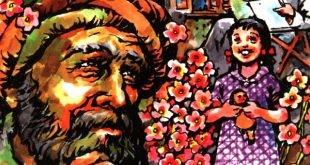The Loving Sister: A rich lady had adopted a poor orphan girl, who was very devoted, obedient, laborious, and always happy and kind.
One day the lady said to her: “Annie, you are a good girl and therefore for Christmas I shall buy some new clothes for you. I have already spoken to the shopkeeper about it. Here is the money; go and buy the smart dress that you desire so much.”
The Loving Sister: Short Story by C. Schmid
The lady gave her some money, but Annie, considering the sum for a moment, said: “My dear mother, I have enough clothes for the present, while my sister Frances is still poorly dressed and if she saw me with a new dress she would certainly feel a little sad. Will you allow me to send her the money? She is very fond of me and when I was ill she used to come to my beside and be the most loving nurse.”
“My dear child,” said the good lady, “write to your sister and tell her to come here and stay with us, and I will give the same to both of you. Since you both have the same love for each other, I shall do my best to keep both of you happy.”
For there is no friend like a sister
In calm or stormy weather,
To cheer one on the tedious way,
To fetch one if one goes astray.
~ C. Schmid [Translated from the Italian by Michael J. Byrnes]
Writer of children’s stories and educator, b. at Dinkelsbuehl, in Bavaria, 15 Aug., 1768; d. at Augsburg in 1854. He studied theology at Dillingen, and, having been ordained priest in 1791, served as assistant in several parishes till 1796, when he was placed at the head of a large school in Thannhausen on the Mindel, where he taught for many years. He soon began writing books for children, of which the earliest was “First Lessons about God for the Little Ones”, written in words of one syllable; next, a “Bible History for Children”, a work which became very popular far beyond the confines of Bavaria; and, lastly, his famous stories for children. From 1816 to 1826 he was parish priest at Oberstadion in Würtemberg. In the latter year he was appointed canon of the Cathedral of Augsburg, where he died of cholera in his eighty-seventh year. In 1841 he began the publication of a complete edition in twenty-four volumes of his scattered writings. In the introduction he tells his readers how his stories were written. They were not composed for an unknown public, and in a mercenary spirit, but for children, among whom the author daily moved, and were not at first meant for publication. To enforce his lessons in religious instruction, he sought to illustrate them by examples taken from Christian antiquity, from legends, and other sources. Usually a story or a chapter was read to the children after school hours as a reward, on condition that they should write it down at home. He thus became familiar with the range of thought and the speech of children, and was careful to speak their language rather than that of books. He was able to observe with his own eyes what it was that impressed the minds and hearts of children both of tender and of riper years. Their manner of repeating the stories also helped him.
 Kids Portal For Parents India Kids Network
Kids Portal For Parents India Kids Network







